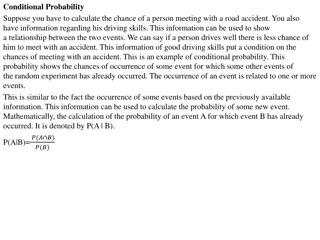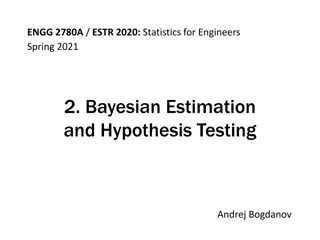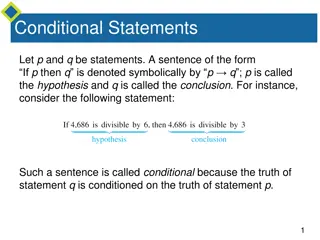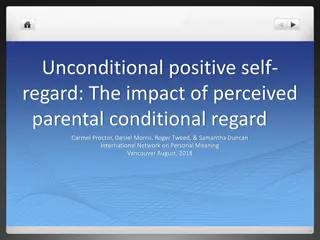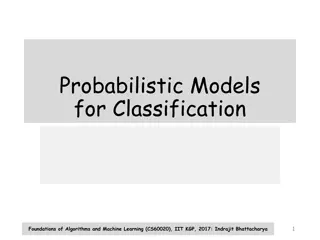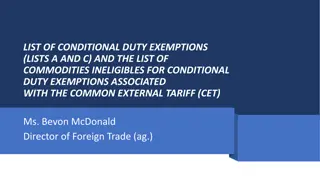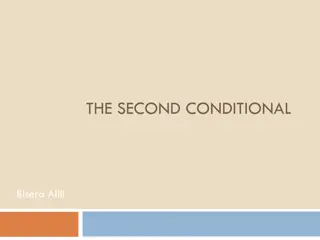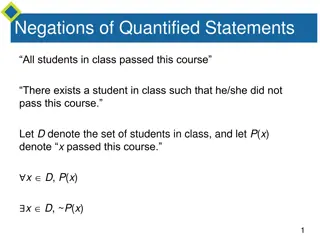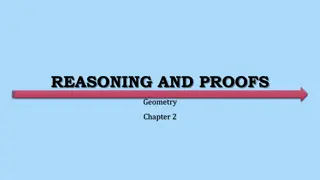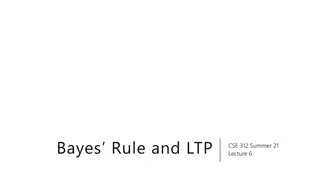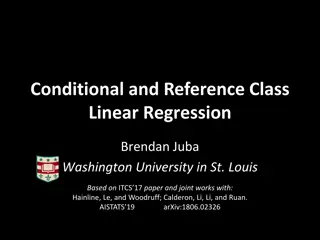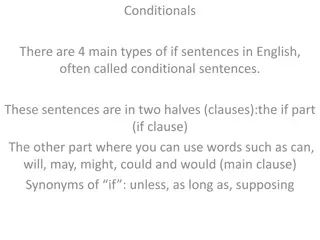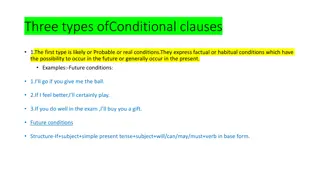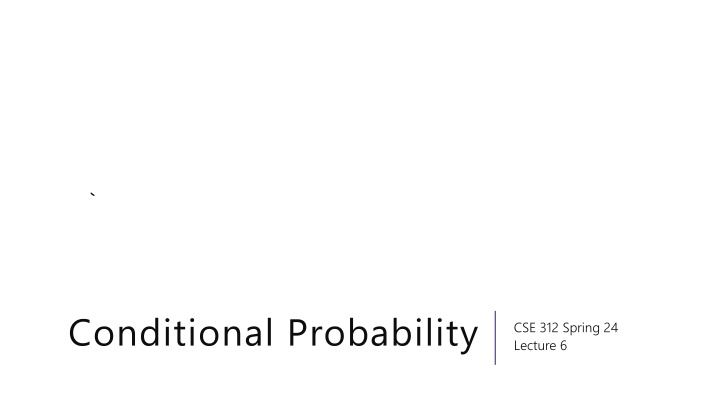
Conditional Probability with Examples in CSE 312 Spring 24 Lecture 6
Explore examples of conditional probability in CSE 312 Spring 24 Lecture 6, including scenarios like shuffling a deck of cards to find the probability of the top two cards having the same value. Gain insights into probability spaces, measures, and events to deepen your understanding of the concept.
Download Presentation

Please find below an Image/Link to download the presentation.
The content on the website is provided AS IS for your information and personal use only. It may not be sold, licensed, or shared on other websites without obtaining consent from the author. If you encounter any issues during the download, it is possible that the publisher has removed the file from their server.
You are allowed to download the files provided on this website for personal or commercial use, subject to the condition that they are used lawfully. All files are the property of their respective owners.
The content on the website is provided AS IS for your information and personal use only. It may not be sold, licensed, or shared on other websites without obtaining consent from the author.
E N D
Presentation Transcript
Conditional Probability CSE 312 Spring 24 Lecture 6
But first one more example with uniform probability spaces!
Another Example Suppose you shuffle a deck of cards so any arrangement is equally likely. What is the probability that the top two cards have the same value? Sample Space Probability Measure Event Probability
Another Example Suppose you shuffle a deck of cards so any arrangement is equally likely. What is the probability that the top two cards have the same value? Sample Space: { ?,? :? and ? are different cards } Probability Measure: uniform measure ? = Event: all pairs with equal values Probability: 13 ? 4,2 52 51 1 52 51
Another Example Suppose you shuffle a deck of cards so any arrangement is equally likely. What is the probability that the top two cards have the same value? Sample Space: Set of all orderings of all 52 cards Probability Measure: uniform measure ? = Event: all lists that start with two cards of the same value Probability: 13 ? 4,2 50! 52! 1 52!
Another Example Suppose you shuffle a deck of cards so any arrangement is equally likely. What is the probability that the top two cards have the same value? Sample Space: Set of all orderings of all 52 cards Probability Measure: uniform measure ? = Event: all lists that start with two cards of the same value Probability: 13 ? 4,2 50 49 48 . 2 1 52 51 50 49 48 2 1 1 52!
Takeaway There s often information you don t need in your sample space. It won t give you the wrong answer. But it sometimes makes for extra work/a harder counting problem, Good indication: you cancelled A LOT of stuff that was common in the numerator and denominator.
Few notes about events and samples spaces If you re dealing with a situation where you may be able to use a uniform probability space, make sure to set up the sample space in a way that every outcome is equally likely. Try not overcomplicate the sample space only include the information that you need in it. When you define an event, make sure it is a subset of the sample space!
Some Quick Observations For discrete probability spaces (the kind we ve seen so far) ? = 0 if and only if ? ? = 1 if and only if ?
Some Quick Observations For discrete probability spaces (the kind we ve seen so far) ? = 0 if and only if an event can t happen. ? = 1 if and only if an event is guaranteed (every outcome outside ? has probability 0).
Conditioning You roll a fair red die and a fair blue die (without letting the dice affect each other). But they fell off the table and you can t see the results. I can see the results I tell you the sum of the two dice is 4. What s the probability that the red die shows a 5, conditioned knowing the sum is 4? conditioned on
Conditioning You roll a fair red die and a fair blue die (without letting the dice affect each other). But they fell off the table and you can t see the results. I can see the results I tell you the sum of the two dice is 4. What s the probability that the red die shows a 5, conditioned knowing the sum is 4? It s 0. Without the conditioning it was 1/6. conditioned on
Conditioning When I told you the sum of the dice is 4 we restricted the sample space. The only remaining outcomes are { 1,3 , 2,2 , 3,1 } out of 1,2,3,4,5,6 {1,2,3,4,5,6}. Outside the (restricted) sample space, the probability is going to become 0. What about the probabilities inside?
Conditional Probability Conditional Probability For an event ?, with ? > 0, the Probability of ? conditioned on ? is ? ? = ? ? ? Just like with the formal definition of probability, this is pretty abstract. It does accurately reflect what happens in the real world. If ? = 0, we can t condition on it (it can t happen! There s no point in defining probabilities where we know ? has not happened) (?|?) is undefined undefined when ? = 0. .
Conditioning D2=1 D2=2 D2=3 D2=4 D2=5 D2=6 (1,1) (1,2) (1,3) (2,1) (2,2) (2,3) (3,1) (3,2) (3,3) (4,1) (4,2) (4,3) (5,1) (5,2) (5,3) (6,1) (6,2) (6,3) Let ? be the red die is 5 Let ?be the sum is 4 Let ?be the blue die is 3 D1=1 D1=2 D1=3 D1=4 D1=5 D1=6 (1,4) (2,4) (3,4) (4,4) (5,4) (6,4) (1,5) (2,5) (3,5) (4,5) (5,5) (6,5) (1.6) (2,6) (3,6) (4,6) (5,6) (6,6)
Conditioning D2=1 D2=2 D2=3 D2=4 D2=5 D2=6 (1,1) (1,2) (1,3) (2,1) (2,2) (2,3) (3,1) (3,2) (3,3) (4,1) (4,2) (4,3) (5,1) (5,2) (5,3) (6,1) (6,2) (6,3) Let ? be the red die is 5 Let ?be the sum is 4 Let ?be the blue die is 3 D1=1 D1=2 D1=3 D1=4 D1=5 D1=6 (1,4) (2,4) (3,4) (4,4) (5,4) (6,4) (1,5) (2,5) (3,5) (4,5) (5,5) (6,5) (1.6) (2,6) (3,6) (4,6) (5,6) (6,6) (?|?)
Conditioning D2=1 D2=2 D2=3 D2=4 D2=5 D2=6 (1,1) (1,2) (1,3) (2,1) (2,2) (2,3) (3,1) (3,2) (3,3) (4,1) (4,2) (4,3) (5,1) (5,2) (5,3) (6,1) (6,2) (6,3) Let ? be the red die is 5 Let ?be the sum is 4 Let ?be the blue die is 3 D1=1 D1=2 D1=3 D1=4 D1=5 D1=6 (1,4) (2,4) (3,4) (4,4) (5,4) (6,4) (1,5) (2,5) (3,5) (4,5) (5,5) (6,5) (1.6) (2,6) (3,6) (4,6) (5,6) (6,6) (?|?) ? ? = = 0 ? = 3/36 0 ? ? ? = 3/36
Conditioning D2=1 D2=2 D2=3 D2=4 D2=5 D2=6 (1,1) (1,2) (1,3) (2,1) (2,2) (2,3) (3,1) (3,2) (3,3) (4,1) (4,2) (4,3) (5,1) (5,2) (5,3) (6,1) (6,2) (6,3) Let ? be the red die is 5 Let ?be the sum is 4 Let ?be the blue die is 3 D1=1 D1=2 D1=3 D1=4 D1=5 D1=6 (1,4) (2,4) (3,4) (4,4) (5,4) (6,4) (1,5) (2,5) (3,5) (4,5) (5,5) (6,5) (1.6) (2,6) (3,6) (4,6) (5,6) (6,6) (?|?)
Conditioning D2=1 D2=2 D2=3 D2=4 D2=5 D2=6 (1,1) (1,2) (1,3) (2,1) (2,2) (2,3) (3,1) (3,2) (3,3) (4,1) (4,2) (4,3) (5,1) (5,2) (5,3) (6,1) (6,2) (6,3) Let ? be the red die is 5 Let ?be the sum is 4 Let ?be the blue die is 3 D1=1 D1=2 D1=3 D1=4 D1=5 D1=6 (1,4) (2,4) (3,4) (4,4) (5,4) (6,4) (1,5) (2,5) (3,5) (4,5) (5,5) (6,5) (1.6) (2,6) (3,6) (4,6) (5,6) (6,6) (?|?) ? ? = 1/36 ? = 6/36 ? ? ? =1/36 6/36
Conditioning Practice Red die 6 conditioned on sum 7 Red die 6 conditioned on sum 9 Sum 7 conditioned on red die 6 . Take a few minutes to work on this with the people around you! (also on your handout) D2=1 D2=2 D2=3 D2=4 D2=5 D2=6 (1,1) (1,2) (1,3) (2,1) (2,2) (2,3) (3,1) (3,2) (3,3) (4,1) (4,2) (4,3) (5,1) (5,2) (5,3) (6,1) (6,2) (6,3) D1=1 D1=2 D1=3 D1=4 D1=5 D1=6 (1,4) (2,4) (3,4) (4,4) (5,4) (6,4) (1,5) (2,5) (3,5) (4,5) (5,5) (6,5) (1.6) (2,6) (3,6) (4,6) (5,6) (6,6)
Conditioning Practice A ~ Red die 6 B ~ Sum is 7 D2=1 D2=2 D2=3 D2=4 D2=5 D2=6 (1,1) (1,2) (1,3) (2,1) (2,2) (2,3) (3,1) (3,2) (3,3) (4,1) (4,2) (4,3) (5,1) (5,2) (5,3) (6,1) (6,2) (6,3) D1=1 D1=2 D1=3 D1=4 D1=5 D1=6 (1,4) (2,4) (3,4) (4,4) (5,4) (6,4) (1,5) (2,5) (3,5) (4,5) (5,5) (6,5) (1.6) (2,6) (3,6) (4,6) (5,6) (6,6) ? ? = (? ?)/?(?) = =1/6
Conditioning Practice A ~ Red die 6 C ~ Sum is 9 D2=1 D2=2 D2=3 D2=4 D2=5 D2=6 (1,1) (1,2) (1,3) (2,1) (2,2) (2,3) (3,1) (3,2) (3,3) (4,1) (4,2) (4,3) (5,1) (5,2) (5,3) (6,1) (6,2) (6,3) D1=1 D1=2 D1=3 D1=4 D1=5 D1=6 (1,4) (2,4) (3,4) (4,4) (5,4) (6,4) (1,5) (2,5) (3,5) (4,5) (5,5) (6,5) (1.6) (2,6) (3,6) (4,6) (5,6) (6,6) ? ? = (? ?)/?(?) = =1/4
Conditioning Practice B ~ Sum is 7 A ~ Red die is 6 D2=1 D2=2 D2=3 D2=4 D2=5 D2=6 (1,1) (1,2) (1,3) (2,1) (2,2) (2,3) (3,1) (3,2) (3,3) (4,1) (4,2) (4,3) (5,1) (5,2) (5,3) (6,1) (6,2) (6,3) D1=1 D1=2 D1=3 D1=4 D1=5 D1=6 (1,4) (2,4) (3,4) (4,4) (5,4) (6,4) (1,5) (2,5) (3,5) (4,5) (5,5) (6,5) (1.6) (2,6) (3,6) (4,6) (5,6) (6,6) ? ? = (? ?)/?(?) = =1/6
Conditioning Practice Red die 6 conditioned on sum 7 1/6 Red die 6 conditioned on sum 9 1/4 Sum 7 conditioned on red die 6 1/6 D2=1 D2=2 D2=3 D2=4 D2=5 D2=6 (1,1) (1,2) (1,3) (2,1) (2,2) (2,3) (3,1) (3,2) (3,3) (4,1) (4,2) (4,3) (5,1) (5,2) (5,3) (6,1) (6,2) (6,3) D1=1 D1=2 D1=3 D1=4 D1=5 D1=6 (1,4) (2,4) (3,4) (4,4) (5,4) (6,4) (1,5) (2,5) (3,5) (4,5) (5,5) (6,5) (1.6) (2,6) (3,6) (4,6) (5,6) (6,6)
Direction Matters Are (?|?) and (?|?) the same?
Direction Matters No! (?|?) and (?|?) are different quantities. ( traffic on the highway | it s snowing ) is close to 1 ( it s snowing | traffic on the highway ) is much smaller; there many other times when there is traffic on the highway It s a lot like implications order can matter a lot! (but there are some ?,?where the conditioning doesn t make a difference)
Wonka Bars Willy Wonka has placed golden tickets on 0.1% of his Wonka Bars. You want to get a golden ticket. You could buy a 1000-or-so of the bars until you find one, but that s expensive you ve got a better idea! You have a test a very precise scale you ve bought. If the bar you weigh does does have a golden ticket, the scale will alert you 99.9% of the time. If the bar you weigh does not have a golden ticket, the scale will (falsely) alert you only 1% of the time. If you pick up a bar and it alerts, what is the probability you have a If you pick up a bar and it alerts, what is the probability you have a golden ticket? golden ticket?
Willy Wonka Willy Wonka has placed golden tickets on 0.1% of his Wonka Bars. If the bar you weigh does does have a golden ticket, the scale will alert you 99.9% of the time. If the bar you weigh does not have a golden ticket, the scale will (falsely) alert you only 1% of the time. If you pick up a bar and it alerts, what is the probability you have a If you pick up a bar and it alerts, what is the probability you have a golden ticket? golden ticket? Which do you think is closest to the right answer? A.0.1% B. 10% C.50% D.99%
Conditioning Let ? be the event the scale ALERTS you Let ? be the event your bar has a ticket. What probabilities are each of these? Willy Wonka has placed golden tickets on 0.1% of his Wonka Bars. If the bar you weigh does does have a golden ticket, the scale will alert you 99.9% of the time. If the bar you weigh does not have a golden ticket, the scale will (falsely) alert you only 1% of the time. If you pick up a bar and it alerts, what is the probability you have a golden ticket?
Conditioning Let ? be the event the scale ALERTS you Let ? be the event your bar has a ticket. What probabilities are each of these? Willy Wonka has placed golden tickets on 0.1% of his Wonka Bars. If the bar you weigh does does have a golden ticket, the scale will alert you 99.9% of the time. If the bar you weigh does not have a golden ticket, the scale will (falsely) alert you only 1% of the time. If you pick up a bar and it alerts, what is the probability you have a golden ticket? (?) (?|?) ? ? (?|?)
Conditioning Let ? be the event the scale ALERTS you Let ? be the event your bar has a ticket. What probabilities are each of these? (?) = 0.1% (?|?) = 99.9% (?| ?) = 1% (?|?) = ???
Reversing the Conditioning All of our information conditions on whether ? happens or not does your bar have a golden ticket or not? But we re interested in the reverse conditioning. We know the scale alerted us we know the test is positive but do we have a golden ticket? (?) = 0.1% (?|?) = 99.9% (?| ?) = 1% (?|?) = ???
Bayes Rule ? ? = (?|?) ? ?
Bayes Rule ? ? = (?|?) ? ? What do we know about Wonka Bars? 0.999 = ? ? (?) .001
Filling In What s (?)? We ll use a trick called the law of total probability : ? = ? ? ? + ? ? ? ? = 0.999 .001 + .01 .999 = .010989
Law of Total Probability Let ?1,?2, ,?? be a partition partition of . . A partition of a set ? is a family of subsets ?1,?2, ,?? such that: ?? ??= for all ?,? and ?1 ?2 ??= ?. i.e. every element of is in exactly one of the ??.
Law of Total Probability Law of Total Probability Let ?1,?2, ,?? be a partition of . For any event ?, ? = ?|?? (??) ??? ?
Why? ? ?1 ?3 ?2 The Proof is actually pretty informative on what s going on. all ? ?|?? (??) ? ?? ?? = all ? ? ?? = (?) The ?? partition , so ? ?? partition ?. Then we just add up those probabilities. Ability to add follows from the countable additivity axiom. (??) (definition of conditional probability) = all ?
Bayes Rule What do we know about Wonka Bars? 0.999 = ? ? .010989 .001 1 11, i.e. about 0.0909. Solving ? ? = Only about a 10% chance that the bar has the golden ticket!
Willy Wonka has placed golden tickets on 0.1% of his Wonka Bars. If the bar you weigh does does have a golden ticket, the scale will alert you 99.9% of the time. If the bar you weigh does not have a golden ticket, the scale will (falsely) alert you only 1% of the time. Wait a minute That doesn t fit with many of our guesses. What s going on? Instead of saying we tested one and got a positive imagine we tested 1000. ABOUT ABOUT how many bars of each type are there? (about) (about) 1 with a golden ticket 999 without. Lets say those are exactly right. Lets just say that one golden is truly found (about) (about) 1% of the 999 without would be a positive. Lets say it s exactly 10.
Visually Gold bar is the one (true) golden ticket bar. Purple bars don t have a ticket and tested negative. Red bars don t have a ticket, but tested positive. The test is, in a sense, doing really well. It s almost always right. The problem is it s also the case that the correct answer is almost always no.
Updating Your Intuition Take 1: The test is actually good that there IS a golden ticket when you get a positive result. actually good and has VASTLY increased our belief If we told you your job is to find a Wonka Bar with a golden ticket without the test, you have 1/1000 chance, with the test, you have (about) a 1/11 chance. That s (almost) 100 times better! This is actually a huge improvement!
Updating Your Intuition Take 2: Humans are really bad at intuitively understanding very large or very small numbers. When I hear 99% chance , 99.9% chance , 99.99% chance they all go into my brain as well that s basically guaranteed And then I forget how many 9 s there actually were. But the number of 9s matters because they end up cancelling with the number of 9 s in the population that s truly negative. We ll talk about this a little more on Friday in the applications.
Updating Your Intuition Take 3: View tests as updating your beliefs, not as revealing the truth. Bayes Rule says that (?|?) has a factor of (?) in it. You have to translate The test says there s a golden ticket to the test says you should increase your estimate of the chances that you have a golden ticket. A test takes you from your prior beliefs of the probability to your posterior beliefs.

